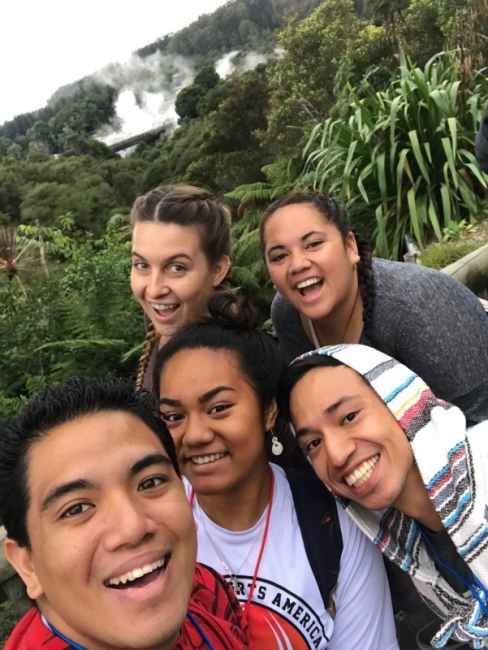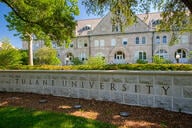You have /5 articles left.
Sign up for a free account or log in.

Windward Community College students in New Zealand
Courtesy of Sarah Hadmack at Windward Community College
Windward Community College administrators had long wanted to establish study abroad programs for students. But the small two-year college in Hawaii didn't have the infrastructure set up for it.
Things changed three years ago after the college applied for and received a $50,000 grant from the State Department’s Bureau of Educational and Cultural Affairs to create two short-term, faculty-led study abroad programs -- Footholds Abroad -- in England and New Zealand. The college also used the grant -- which could not be used to directly fund student travel -- to help create a study abroad center and website where students could get information about the study abroad opportunities available to them, including programs run by the University of Hawaii system, of which Windward is a part.
Windward had not consistently run its own study abroad programs before 2016. But the college has since offered the England program three times and the New Zealand program twice. It has also offered faculty-led programs in Costa Rica and the Czech Republic. Plans are in the works for new programs in Ireland and Taiwan next year and a second program in England.
Sarah Hadmack, an associate professor of religion and director of study abroad at Windward, said the funding helped the college "create a model" it could use for creating additional faculty-led programs.
"It was just what we needed to really get the ball rolling," she said.
Nationally, about 11 percent of undergraduate students study abroad at some point in their degree programs, but the percentages who study abroad vary dramatically across some institutions. Some private liberal arts colleges boast 100 percent participation, or very close to it, while other institutions send very small numbers of students overseas.
Students at community colleges and minority-serving institutions, or MSIs, tend to study abroad at lower rates: less than 1 percent of students at community colleges study abroad during their degree program, while 5 percent of students at minority-serving institutions study abroad, according to data from the Institute of International Education, which conducts an annual survey of study abroad participation rates. But those numbers may soon grow; there is intense interest at many MSIs and community colleges in expanding study abroad opportunities for their students.
The Bureau of Educational and Cultural Affairs, or ECA, has provided more than $10 million in small grants to 90 higher education institutions since 2009 to help expand study abroad opportunities. Of the 90 colleges that have received grants, 29 are minority-serving institutions and 18 are two-year institutions (some fall into both categories). The grants fund projects that build capacity to expand or diversify the student populations that study abroad or the destinations where they study -- more than 70 percent of students who study abroad are white, and more than 50 percent study in Western Europe.
Some of the grant recipients send much larger proportions of their students abroad than others. Sul Ross State University, a Hispanic-serving institution in West Texas, sends less than 0.1 percent of its undergraduates abroad each year. Sul Ross has a high proportion of students with financial need: 64 percent of undergraduates receive federal Pell Grants.
“We also have a very high percentage of students who are first-generation college students,” said Esther Rumsey, the director of international studies and a professor of communication at Sul Ross. “Trying to do a whole semester abroad is not something that’s financially viable for the majority of our students.”
Sul Ross is using a newly awarded $35,000 State Department grant to develop study abroad programs -- one- to two-week trips -- that are embedded into core curriculum classes.
“It offers a travel opportunity for students early in their college career, like second semester freshmen year, or sophomore year,” Rumsey said.
She's hoping that a short-term study abroad experience will lead students to consider doing a full semester abroad or exploring other international study opportunities such as a Benjamin A. Gilman Scholarship, a State Department program that provides scholarships for study abroad and international internships for Pell Grant recipients.
“But I think the first step is to get them a passport and get them out of the country once so they see that it is something that is not just for elites -- a broad variety of people can go,” Rumsey said.
Other institutions are using grant funding for more targeted outreach. Augustana University, in South Dakota, sends about 200 students abroad a year, mostly on short-term programs during the January term. About half of its students study abroad over the course of their undergraduate career. The university is using an approximately $21,000 grant to fund faculty travel to develop a new study abroad site in Kenya and to fund a part-time, one-year position to analyze the college’s study abroad participation data.
“This research position is giving somebody 20 hours a week to dig into all this data that we have about the students that have gone abroad -- the faculty who have led, and what courses -- and compare that to our student body,” said Erin Kane, the assistant director of international studies at Augustana. “What we really want to see is who isn’t going and why not and be able to offer specific courses that are going to target these students because of interest or major or location or whatnot.”
Some colleges have used the grants for building up their administrative infrastructure for study abroad. Shepherd University, in West Virginia, used a 2016 grant of roughly $50,000 to help establish a study abroad office. Yin Star, who was appointed to be Shepherd's first full-time study abroad director, used part of the grant to get professional certification from the Forum on Education Abroad so she could set the office up in line with best practices in the field.
"It allowed seed money for me to be able to come to Shepherd and do the job," Star said. "It allowed me to form a study abroad club, it allowed me to get the study abroad photo contest going, it allowed me to really take charge of putting the word out there for students to think about study abroad, and it allowed me to build my website."
Other colleges have used the State Department grants to fund development of specific programs. Santa Fe College, a community college in Florida, used a 2017 grant to develop a new biotechnology internship program in partnership with the State University of São Paulo, in Brazil. Four students participated in the inaugural year, and another iteration of the program is planned for next summer.
“As an institution that serves a high percentage of economically disadvantaged youth and a high percentage of minority students -- most of our students are working, some of them full-time, and they have busy, active lives -- people dream about study abroad, but they see it as something that’s not possible,” said Vilma Fuentes, the assistant vice president of academic affairs at Santa Fe College. “Being able to have a grant-funded project that shows the viability of this and to be able to tie it directly to an academic program … to say, ‘This can be the pinnacle of your bachelor’s,’ it was a very powerful project, I think.” (Santa Fe College, like other community colleges in Florida, offers a number of bachelor's degree programs.)
Gallaudet University, a college for deaf and hard-of-hearing students, is using a newly awarded grant to develop resources to support access for deaf students to study abroad.
Becca AbuRakia-Einhorn, Gallaudet’s coordinator of education abroad, said study abroad provider organizations have a "wide spectrum" of practices when it comes to accommodating deaf students. “Generally, a lot of these study abroad organizations will say, ‘We will do our best,’ and the problem is that we end up reinventing the wheel every time we’re trying to work with them,” she said.
“I get calls and emails multiple times per week from people from other universities who say, ‘I have a deaf student who walks into my office; she wants to go to Semester at Sea -- what do I do?’ Someone wrote to me and asked, ‘What’s the standard way to pay an interpreter?’ There is no standard.”
AbuRakia-Einhorn hopes to publish case study information on how colleges and study abroad providers have handled accommodations for deaf students. Another goal is to highlight the work of deaf travel bloggers. "The goal at the end is to collect a lot of different resources that will help advisers work with students who are deaf, that will help students who are deaf feel empowered to navigate the study abroad process, and lastly to help study abroad providers make their programs more accessible," she said.
The study abroad capacity-building grants are not especially large -- in 2019 the largest grant available was $35,000 -- but the projects point to various ways in which institutions of varying types and study abroad participation levels are thinking about expanding opportunities and diversifying participation.
“Our evaluations of the program show that the capacity-building program is helping U.S. higher education institutions sustainably build their study abroad capacity,” Caroline Casagrande, the deputy assistant secretary for academic programs at the State Department, said via email. “For example, we recently finished a multiyear evaluation of the 17 grants we funded in 2016 and found that more than 700 U.S. students -- nearly half from groups underrepresented in study abroad -- participated in programs supported by our small grants that year. Grantee institutions established 71 new global partnerships, formalized 47 new memorandums of understanding and strengthened 33 existing MoUs that they will use to increase their study abroad programs and numbers for years to come."
At Windward, one of the programs established with the help of the State Department grant, a two-week theater program in England, just completed its third run. Nicolas Logue, an assistant professor of theater who co-directs the program, said the college has obtained grant funding and support from a number of institutions, including a grant from the Shakespeare Birthplace Trust, to bring the cost down to a nominal amount for students. The students who participated in the program this summer paid only for their airfare in addition to the regular cost of tuition for a three-credit course, he said. They spent a week in London at the East 15 Acting School and a week in Shakespeare’s birthplace of Stratford-upon-Avon.
“It’s led to such amazing training and career opportunities for students,” Hadmack, the study abroad director, said of the program. Two Windward students have successfully auditioned for East 15 while they were there (one deferred to pursue professional acting opportunities, according to Logue).
“The cool thing is that trip has led to a deeper partnership with both Shakespeare Birthplace Trust and East 15 Acting School,” Logue said. “We’re exploring more and more exciting things with them, not just sending them a cohort of students every year, though we’ll still continue to do that.”




